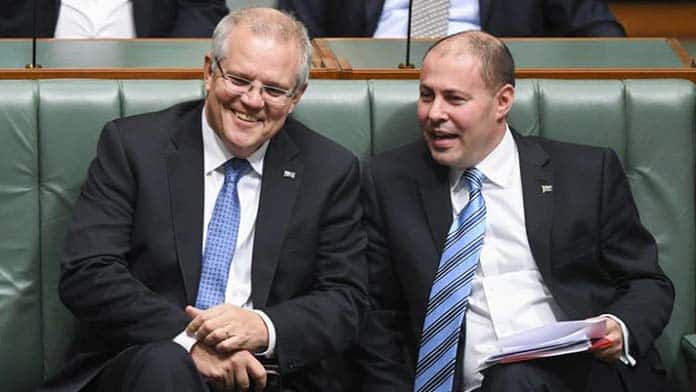The Liberals have produced a budget full of short-term bribes for the election. But despite shovelling $8.6 billion into tax cuts and payments, tens of billions into the military and billions more into new business subsidies, spending on climate change has actually dropped and there is nothing to fix the crisis in aged care or hospitals exposed by the pandemic.
The government knows workers are feeling the squeeze with the cost of living and petrol prices rising. Inflation is expected to climb to 4.25 per cent by June.
Its response is a series of short-term measures, most of which kick in before the election is due in less than eight weeks. It will cut fuel excise to reduce petrol prices for six months, make one-off payments of $250 to pensioners and welfare recipients, and a one-off tax cut of $420 for low and middle income workers. But the money handed back in the tax cut, $4 billion, will be more than clawed back the year after, when the temporary low income tax offset ends, recouping $8 billion.
The cost of living is not just a short-term problem due to the war in Ukraine and the pandemic. It’s the result of years of stagnant wage growth, made worse by the Liberals’ attacks on penalty rates, public sector workers and union rights.
Since 2013 when the Coalition came to power wages have barely kept up with inflation. Last year workers copped effective wage cuts of 1.2 per cent, with those on the average wage losing around $800. This year will be worse.
When the pandemic began the federal government froze public sector wages for six months, and the state governments followed suit. Since then it has held them to the same level as average wage rises. This has helped push down wages across the board.
The budget optimistically predicts a turnaround in 2023, with wages rising to outpace inflation. This is just the latest in a series of projections that never came to pass. Casualisation and the decline in union power means workers’ bargaining strength is at a low ebb. The Liberals’ attacks on unions only make the problem worse.
Money for war
An appalling $575 billion is being poured into the military by the end of the decade. Defence spending next year alone will hit $48 billion. A spending spree on new weapons includes $50 billion on new frigates and destroyers, $10 billion for naval infrastructure, $3.5 billion for more tanks, and $6.4 billion on the existing Collins class submarines.
There is also $10 billion over ten years to fund a new cyber warfare centre. An increase in the size of the military, already announced, will cost $38 billion by 2040.
And the estimated $170 billion for nuclear subs has not even been budgeted for, with contracts and plans still being negotiated. Treasurer Josh Frydenberg tried to justify this by declaring that “weakness invites aggression”. But this military buildup simply fuels the arms race with China and heightens tensions in our region.
The money being wasted on weapons could be used to fix the crisis in aged care and hospitals, build renewable energy, or end poverty level JobSeeker payments. This is a budget that fails to deal with any of the real challenges facing working class people, from housing affordability to insecure work or wages growth.
As the nurses’ union’s Federal Secretary Annie Butler said, the budget saw the Liberals, “ignore the plight of nursing home residents, nurses and care workers, by failing to implement the Royal Commission’s key recommendations—safe minimum staffing levels, increased wages for aged care workers and genuine accountability for taxpayers’ money.”
Unions are arguing for a 25 per cent pay rise to help retain aged care staff, in a case currently before the Fair Work Commission. UnitingCare Australia estimates this would cost $4 billion a year, a fraction of the new Defence spending.
Spending on climate change measures will actually decline over the next four years. But there is another $300 million to support gas developments off Darwin, alongside $50 million for pipelines and other gas infrastructure previously announced.
Scrapping the nuclear subs and putting $170 billion into a package of renewable energy and public transport could make a massive difference—and create thousands of new climate jobs.
Shocking
University funding is also being cut, with a 5.4 per cent decline next year and 3.6 per cent decline in the following two years, as a result of reduced payments for student places under the government’s Job-ready Graduates Program passed in 2020. This is despite the shocking 35,000 job cuts in universities last year.
There are a handful of positive measures, including 16,500 additional places for Afghan refugees over four years. This is a result of campaigning by the Afghan community and refugee supporters for an extra 20,000 places following the Taliban takeover of the country last August. There is $1.3 billion to tackle violence against women, including money for crisis accommodation and assistance.
But overall the budget should be seen for what it is—a short-term bribe designed to cover the fall in wages the Liberals helped create—and a transparent effort to win Scott Morrison re-election. We shouldn’t be taken in.
A concerted push from the unions could finish Morrison off. But so far, there has not been a strike or a rally called directed at the Morrison government. Nurses in NSW are striking again to break the Liberal state government pay cap.
But the only response federally from the ACTU is corflutes and billboards, which they called their “secret weapon”. But it’s no secret that workers’ real power is their industrial strength. A cost of living national day of action rally and strike could be the final nail in Morrison’s coffin, and shape the struggle ahead to win real wage rises.
By James Supple






